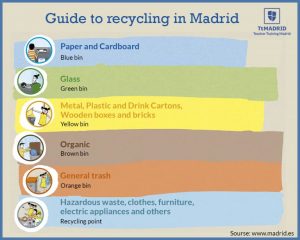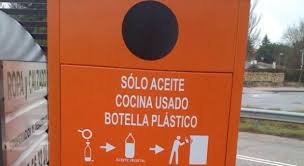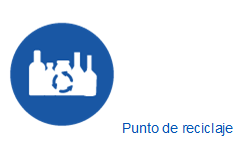 The newly-elected mayor of Madrid swiftly back-tracked from the preposterous idea of reversing the traffic restrictions which the previous administration had wisely introduced in the city centre (limiting access to a zone referred to as Madrid Central) as a first step in becoming an environmentally-friendly European capital. In the years leading up to the implementation of Madrid Central, the capital city had often seen dangerous levels of air pollution and taken drastic short-term measures to tackle it in an ad-hoc fashion. With the local government stepping up to the responsibility of cleaning up the air we breathe, here at Kids in Madrid we want to reflect on what we can do with our kids to reduce our families’ carbon footprint in Madrid and our impact on the local environment.
The newly-elected mayor of Madrid swiftly back-tracked from the preposterous idea of reversing the traffic restrictions which the previous administration had wisely introduced in the city centre (limiting access to a zone referred to as Madrid Central) as a first step in becoming an environmentally-friendly European capital. In the years leading up to the implementation of Madrid Central, the capital city had often seen dangerous levels of air pollution and taken drastic short-term measures to tackle it in an ad-hoc fashion. With the local government stepping up to the responsibility of cleaning up the air we breathe, here at Kids in Madrid we want to reflect on what we can do with our kids to reduce our families’ carbon footprint in Madrid and our impact on the local environment.
Using public transport
One of the most effective ways to reduce our carbon footprint is limiting the number of vehicles in the city and using public transport. Children under the age of 7 travel for free in Madrid. Children under the age of 4 are allowed to use the transport network without the need to show any identification. For kids aged 4, 5 and 6 years old there is a Children’s Travel card which allows children to travel for free until their 7th birthday on the whole of the Public Transport Network of Madrid (all zones). There are a variety of English-language apps to help you navigate the transport system and clear instructions about how to obtain a personal travel card are also available in English.
Traveling by bike
Tourists visiting Madrid have several options to do tours on wheels and thus take advantage of the many cycle paths that make cycling around the city a viable option for residents as well as visitors. The city also has many great parks where you can hire a bicycle (many with seats for toddlers) or you can take your own bikes to places like our personal favourite Parque de Prados de Torrejón in Pozuelo which is also accessible by public transport. This park has a special children’s cycling circuit that is well-worn and whose somewhat deteriorated aspect only belies the trust that thousands of parents have bestowed on it when teaching little ones to ride!
Recycling
Getting to grips with the myriad of recycling options on offer in Madrid is not for the faint-hearted, but once mastered, parents and children alike can marvel on the efforts the city council makes to ensure we can dispose of our waste responsibly and reduce the carbon footprint.
 Trash
Trash
Household waste is disposed of in three different coloured wheelie bins or deposited in colour-coded dumpsters at strategic points on main roads in each neighbourhood. Brown bins are for organic waste, grey bins are for non-recyclable waste and yellow bins are for packaging waste – “envases” – (plastic, metal and tin). Furthermore, there are paper and glass recycling bins (blue and green, respectively) on every third street in the city, whether it be a thoroughfare or a quiet neighbourly cul-de-sac. Old clothes can be recycled in bins marked “recogida de ropa y calzado” that are often close to public buildings and shopping centres.
Batteries
Old phone batteries, AA, AAA and single cell button batteries can all be recycled at bus stop shelters across the city. Ecopilas also has an impressive network of alkaline battery recycling bins in shopping centres, supermarkets, office blocks and schools in Madrid.
Cooking oil
There are 380 fixed places in Madrid capital city where used cooking oil can be taken to be properly disposed of. However in most of the satellite towns of the Comunidad de Madrid you will also find bright orange coloured recycling bins for vegetable oil beside the town hall.
 Hazardous waste, furniture and electrical appliances
Hazardous waste, furniture and electrical appliances
Most shopping centres such as El Corte Inglés and Carrefour have a recycling areas for used lightbulbs, small electrical appliances and mobile phones. Check the “servicios de tienda” area of your local Carrefour website for this symbol to make sure you can take your small electronic waste there when you next do your shopping:
 All hazardous waste, old furniture, electrical appliances, gardening waste, medicines and old CDs/DVDs can be taken to one of the 16 dumps in the city. Known as “puntos limpios”, these dumps have strict rules about when and what can be handled by this public service. When in doubt, it is probably wiser to request an appointment for the local waste removal service to collect your discarded item or advise where it can be taken. Appointments can be made by ringing 91 4382936, online or via the truly excellent @lineamadrid Twitter service. All you need to do is follow the Linea Madrid account on Twitter and then publish a tweet saying:
All hazardous waste, old furniture, electrical appliances, gardening waste, medicines and old CDs/DVDs can be taken to one of the 16 dumps in the city. Known as “puntos limpios”, these dumps have strict rules about when and what can be handled by this public service. When in doubt, it is probably wiser to request an appointment for the local waste removal service to collect your discarded item or advise where it can be taken. Appointments can be made by ringing 91 4382936, online or via the truly excellent @lineamadrid Twitter service. All you need to do is follow the Linea Madrid account on Twitter and then publish a tweet saying:
 They will then contact you directly via the private messaging (D.M.) service on Twitter to arrange the appointment. We guarantee that a fair number of the operators working behind the scenes at Linea Madrid are fluent in English and you won’t have too much trouble making yourself understood.
They will then contact you directly via the private messaging (D.M.) service on Twitter to arrange the appointment. We guarantee that a fair number of the operators working behind the scenes at Linea Madrid are fluent in English and you won’t have too much trouble making yourself understood.
Do you have any other suggestions on how to be responsible for the waste we generate in Madrid and reduce our carbon footprint? We would love to hear from you! Follow us on Facebook and Instagram and share your tips or email them directly, so we can add them to this blog.
